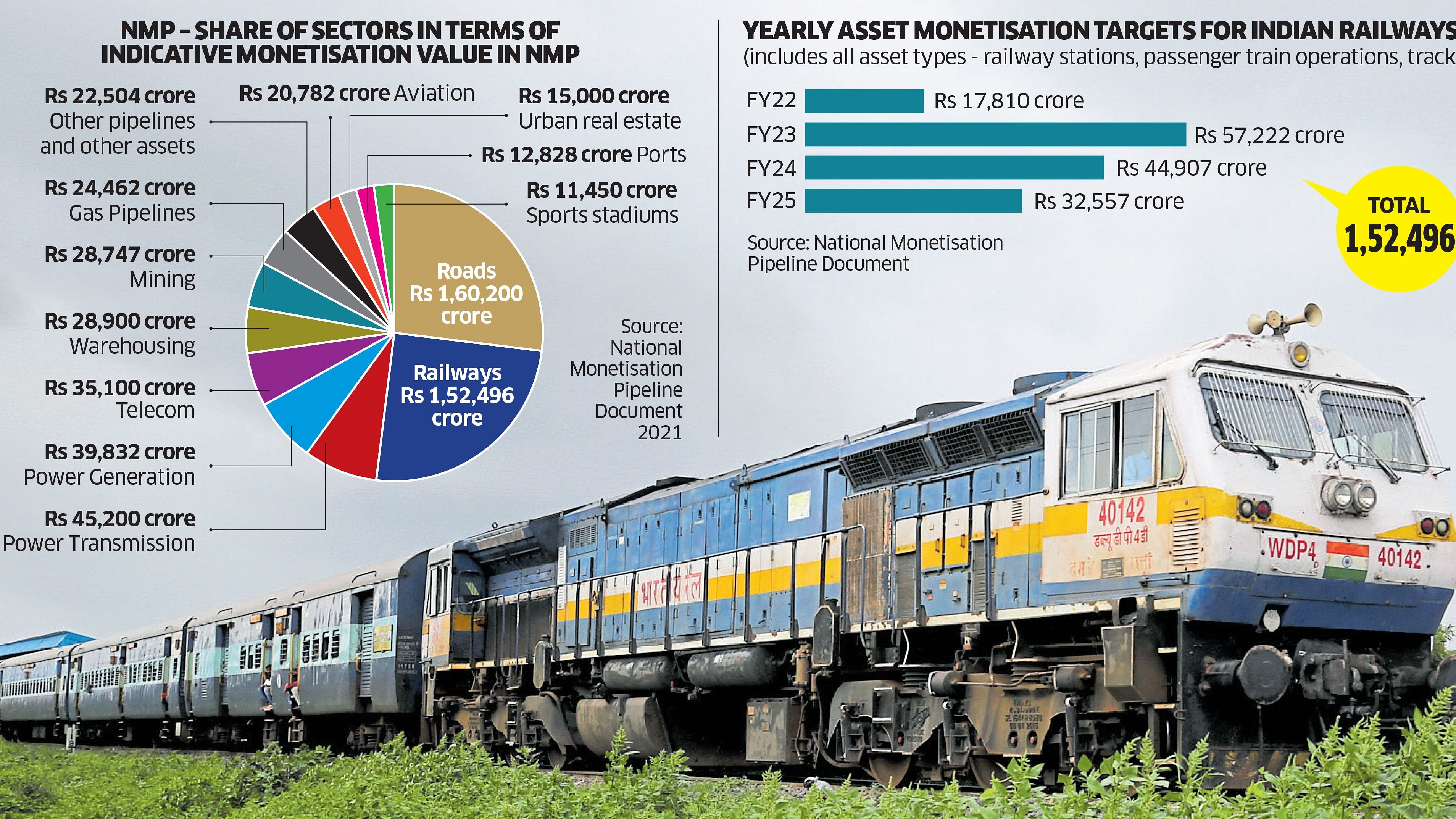
Credit: DH Illustration
The Indian Railways (IR) is unlikely to meet ambitious asset monetisation targets given to it for the four-year period ending 2024-25, several experts and industry insiders told DH.
Over two years after the launch of the National Monetisation Pipeline (NMP), which proposed a monetisation target of Rs 1.52 lakh crore for the railways till FY25, it has been able to achieve only a lower single-digit percentage of this goal, some sources said and the current realisation remains short of aspiration at Rs 20,000 crore per year. Figuratively, it managed asset monetisation of around Rs 30,000 crore against the target of Rs 57,222 crore in FY23.
The Modi government’s asset monetisation plans envisages assets across sectors, which will continue to be owned by the government or state-owned entities, but would be operated and maintained by private sector players, who share a part of the revenue earned with the exchequer.
For the four-year period from 2021-22 to 2024-25, the asset monetisation target across sectors has been kept at Rs 6 lakh crore.
Some of the plans that the railways had come up with included the redevelopment of 400 stations and privatisation of 90 trains and 15 railway stadiums.
Indian Railways’ target for the FY22-FY25 period is the second largest share (26 per cent), second to roadways (27 per cent) which has been pegged at Rs 1.6 lakh crore, followed by power (15 per cent) at Rs 45,200 crores.
Collectively for FY22 and FY23, the total monetisation value (across sectors) realised was Rs 1.14 lakh crore. The government has monetised assets worth Rs 26,000 crore during FY24 against the target of Rs 1.6 lakh crore for the current fiscal while a proposal pipeline aggregating to Rs 1.23 lakh crore is currently at various stages of processing, the NITI Aayog said.
Senior ex-railway officials whom DH spoke to were of the view that top leadership in the government has given the railways ministry leeway, while the progress in other sectors has been relatively better.
“Some sectors, because of their inherent nature, were able to pick up one of the types of monetisation models and were able to move fast,” said Kushal Kumar Singh, a partner at Deloitte, which was appointed to review policies related to private sector participation in IR and suggest innovative models.
Private-sector participation weak
With IR’s focus on augmenting railway infrastructure to facilitate freight and passenger movement, significant investments will be needed to address capacity constraints, states the NMP report. However, little has been done to attract the trust and interest of private investors.
Station development forms the major chunk of asset monetisation plans (over 50 per cent). Together with private passenger train operations, it contributes 97,892 crore — around 65 per cent of the indicative target.
However, the station redevelopment projects, initially proposed in a public-private partnership (PPP) mode, are now being taken up under engineering, procurement and construction (EPC) mode.
Moreover, attempts to privatise train operations have faltered partially owing to the pandemic but more due to risky nature of contracts skewed towards the interest of IR, with players complaining over higher premiums deciding the winning bidder, haulage charges, restrictions on routes and train timings among other concerns, insiders revealed.
“There are fundamental issues in the model and with Indian Railways being a monopsony, the risk perception is enhanced," said Davinder Sandhu, co-founder and chairman of consultancy firm Primus Partners.
Railways are unable to carve off monetisable assets and no investor would buy an asset that is not usable for them, he added.
This has prompted the centre to consider linking capital expenditure allocation to money generated through asset monetisation.
“Capital for such projects is being organised either through the union budget or via loans from the Indian Railway Finance Corporation (IRFC),” said a senior ex-official in the railways.
"To meet the FY25 goal, it is important that IR rethinks its strategy and model for monetisation of assets, considering the experience over the last 3 years. Since land and related assets can be better isolated as standalone profit centers, they are seeing a better response from the market. However, there is a need to find investors for assets like track, workshops, production units, and stations," suggested Sandhu.
An appropriate design of risk sharing in public-private investment programs is also needed.
Poor progress so far
While the intent is correct, the plan was not implemented in the right way,” said Sudhanshu Mani, an ex-railway professional and the visionary behind Vande Bharat Express trains, adding that the progress so far in asset monetisation has been poor, whether in terms of private participation in passenger train operations or station redevelopment or even exploitation of DFCs which are nearing completion with nearly 200 trains being run daily.
Interestingly, the Indian Railway Stations Development Corporation (IRSDC), responsible for station redevelopment, was liquidated last year.
An email sent to the official spokesperson of the Ministry of Railways seeking comments remained unanswered while a spokesperson from Niti Ayog, overlooking the NMP, had sought more time to share the latest progress-related data for the Indian Railways.
Indian Railways is now looking at some specific plans including monetisation of bandwidth of fiber optic cable laid alongside the DFC, setting up of a 100-megawatt solar power plant in the unused road gallery along the DFC and partial monetisation of the Rs 1000 crore multimodal transport hub in Surat among other, sources aware of the developments informed DH.
“While model structures help a lot, we cannot assume a one-size-fits-all situation. We must not force fit monetisation structures on projects. Each type of project must be considered on its merit and if required new approaches to asset monetisation can also be adopted,” Singh added.